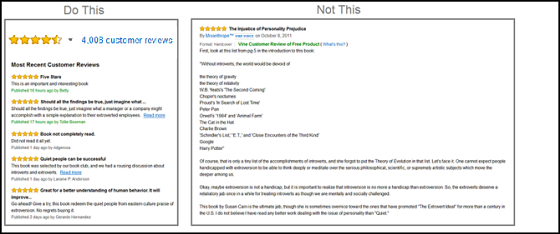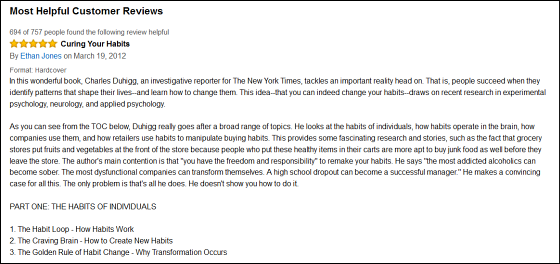For over a decade, MarketingExperiments has stressed the importance of customer reviews.
When our Customer Ratings Tested Web clinic was originally broadcast in 2004, Shopping.com was the third-most popular ecommerce site in America, and Amazon’s annual revenue was a mere 7% of what it has since become.
In the ten years since, customer reviews have gone from being a supplemental component of our marketing strategy to the single biggest influencer of consumer behavior. In a 2013 survey by Dimensional Research, 90% of customers responded that their buying decisions are influenced by online reviews. A similar study conducted by Retailing Today found that 81% of consumers conduct online research before making major purchases.
With the knowledge that customer reviews are now one of the most vital components of our marketing collateral, how can we make sure that we are presenting our reviews in a way that best serves our customers?
New ecommerce research by Dr. Raffaele Filieri hopes to answer that question.
Filieri specializes in consumer behavior and digital marketing at Newcastle Business School, whose recent double accreditation by the Advance Collegiate Schools of Business (AACSB International) puts it in the top 1% of business schools in the world.
His independent study, “What makes online reviews helpful? A diagnosticity-adoption framework to explain informational and normative influences in e-WOM,” published offline in the Journal of Business Research, not only confirms that customer reviews carry more clout than almost all other marketing efforts but, for the first time, reveals how customers actually process online reviews.
Below are four key takeaways we can learn from his research:
Takeaway #1. Customers process review data quickly
In his study of brands such as Kia Motors and TripAdvisor, Filieri found that customers are not carefully reading review data. Instead, they are scanning it quickly.
When processing review data, users are looking to gather as much information as they can in the shortest amount of time possible. Users don’t want to search for or through reviews; they want quick visual summaries of the sentiments of other customers.
As marketers, we must be aware of this fact and provide prominent, easily scannable customer reviews whenever possible.
Takeaway #2. Customers are more concerned with star or numeric ratings than actual review content
Through his research, Filieri discovered that customers pay more attention to star ratings or aggregate review data than they do to the actual written review content on the page.
Aggregated scores, whether they be an average star rating used by sites like Amazon or a weighted score similar to those seen on sites like Rotten Tomatoes and MetaCritic, are assigned more weight by customers than an assortment of long, informative review essays.
If your business enjoys multiple strong review scores, Filieri’s study suggests that it may be better to display eight five-star reviews with two lines of text, for example, than two five-star reviews with large blocks of copy.
Takeaway #3. The credibility of the reviewer is surprisingly unimportant
When researching the ways that customers process customer ratings, Filieri found that the credibility of the person writing the review was surprisingly unimportant. Even anonymous reviews seemed to carry a similar amount of weight as credited reviews. We shouldn’t always feel the need to prioritize reviews from well-known or highly credible sources if we have a stronger, punchier review available from a lesser-known source.
Using Amazon as an example, more often than not, the reviews flagged as most helpful by customers are not from celebrity endorsers or experts in the field. Instead, they are usually from ordinary people who were able to provide the type of quick, scannable information most valuable to readers.
In the below example, Amazon customers browsing for information about author and MarketingSherpa Summit 2016 featured speaker Charles Duhigg’s best-selling book The Power of Habit found this ordinary review most helpful:
Takeaway #4. Good customer service remains the strongest form of marketing
Our 2004 MarketingExperiments Web clinic on customer reviews urged businesses to stop thinking of customer service as a basic cost of doing business, but instead view it as a legitimate marketing expense.
Ten years later, Dr. Filieri’s study confirms that customer reviews have never been more important. These user reviews have become the Better Business Bureau or Consumer Reports of the twenty-first century and have the increasing power to make or break businesses, suggesting that the need for this customer-first paradigm shift has never been greater.
For small, specialty businesses, one poor customer review is often all it takes to significantly damage the public’s perception of us.
The silver lining, however, is that the power to control our reputation lies firmly in our hands. By putting the customer first at every step of the journey, from capture to retention, we have the ability to influence the influencers.
One company, Tech Armor, literally built their business on the foundation of customer reviews. “We really built our brand around service and support,” Joseph Jaconi, General Manager, told MarketingSherpa at IRCE 2015. “We’re a small company, but over 60% of our human resources is dedicated to customer service and support … that’s including sales, marketing and everything we’re doing.”
By putting our full force behind customer satisfaction, actively working to earn favorable reviews, and presenting those reviews in an easily digestable way to resonate with our prospects, we give ourselves the best chance for success over the coming decades.
You might also like
MarketingSherpa Summit 2016 — At the Bellagio in Las Vegas, February 22-24
Personalized Messaging Tested: How little changes to an email send led to a 380% change in response rate — Latest MarketingExperiments’ Web clinic
E-commerce Marketing: Top takeaways from the MarketingSherpa Media Center at IRCE
Responsive Design Tested: What a recent experiment reveals about the potential ROI of mobile design





